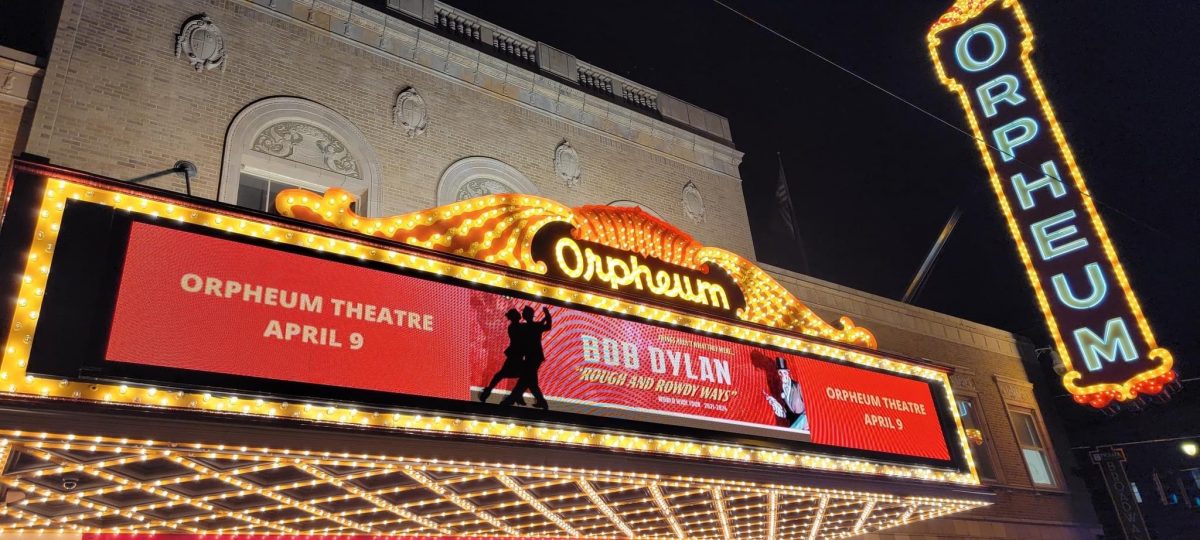Bob Dylan’s appearance at the Orpheum Theatre on Saturday felt momentous even before we arrived. Something about the confluence of our tentative return to public life, his own dogged determination, and the historic upheavals we’re all experiencing lent his appearance a greater significance than ever.
Perhaps that’s why the full house spontaneously rose to a standing ovation as soon as Dylan and his band took the stage. And though Dylan has never varied from a fixed setlist on recent tours, opening with the blues shuffle of “Watching the River Flow” was especially appropriate for a gathering in a classic theater at the foot of Beale Street, just a stone’s throw from the Mississippi.
It was especially moving if one paused to reflect that the Orpheum is still standing because of the efforts of musical auteur Jim Dickinson and other activists, who’s efforts prevented the destruction of the theater in the ’70s. Years later, when Dylan’s Time Out of Mind won a Grammy, he would name check the native Memphian in his acceptance speech. “This is for my brother, Jim Dickinson. He lives in Mississippi.”
Their common roots were highlighted with an opening tune dating back to the early ’70s, and the prominence of piano (Dickinson’s instrument of choice) in Saturday’s performance. Dylan hasn’t touched a guitar onstage for some time now, but hearing him play only piano was a first for this listener. (The last time I saw him was at Mud Island in the ’90s). It seemed entirely appropriate that Dylan’s instrument was neither some digital keyboard nor a grand piano, but a barrelhouse console piano with its back to the audience. Dylan spent the night standing at it with only his head and shoulders visible. But, given that he would occasionally step out stoically from behind it to accept applause, that was enough.
The band, with drummer Charlie Drayton, guitarists Doug Lancio and Bob Britt, multi-instrumentalist Donnie Herron, and longtime bassist Tony Garnier, would often noodle about in the key of each upcoming song, especially on the slower numbers. This sometimes made the quieter pieces seem to emerge from a cloud of notes, as if coalescing out of stardust. It also emphasized the living spontaneity of the performances.

While most of the set was drawn from his 2020 album, Rough and Rowdy Ways, the second song, “Most Likely You Go Your Way and I’ll Go Mine,” also harked back to Dylan’s far past, with a far more ethereal approach, the band tentatively easing into a quieter treatment that was no less powerful for it.
They took quite the opposite approach a few songs in, when Dylan launched another classic track, “When I Paint My Masterpiece,” with a deft blues harp boogie. That, too, benefited from the new arrangement, and suited the proximity of Beale Street to a T.
The songs from his latest album were no less enthusiastically received. The steadfast blues shuffle/march of “False Prophet” was so powerful that the crowd rose to its second standing ovation as the music drew to a close, with Dylan stepping out to receive the adulation. His grim demeanor only served to highlight the gravitas of the lyrics. This singer was clearly in the zone.
“Black Rider,” while not as spare as the album version, showcased the band’s more subtle side, sans drums. And when they kicked off the next tune with a groovy boogie riff, many did not realize it was the 1967 gem, “I’ll Be Your Baby Tonight.” The strong riffs underpinning “Gotta Serve Somebody” were similarly disorienting, but once you realized what was happening, the old songs took on added power, and, in the latter case, led to yet another standing ovation.
The one glimmer of joy in Dylan’s demeanor came during the lilting waltz, “I’ve Made Up My Mind to Give Myself to You.” The tender, reflective tune had a dramatic silence at one point, promptly filled by a fan yelling, as if on cue, “We love you, Bob!” As Dylan resumed singing, he let out an irrepressible laugh.
The songwriter’s Frank Sinatra fascination bubbled to the surface in the form of “Melancholy Mood,” a revelation of sorts in the loose but focused energy brought by the band. And then he brought it close to the heart of Memphis with the quiet “Mother of Muses.” Applause and a shiver of recognition rippled through the crowd as Dylan sang:
Sing of Zhukov and Patton and the battles they fought
Who cleared the path for Presley to sing
Who carved out the path for Martin Luther King
Who did what they did and then went on their way
Man, I could tell their stories all day
After “Goodbye Jimmy Reed,” Dylan introduced the band, name checking Sam Phillips along the way, and then drew the night to a close with the magnificent “Every Grain of Sand.” The crowd tried to rally for an encore, but most knew that the evening was complete. Dylan was done, and so were we, satisfied to have seen one of the 20th Century’s greatest visionaries make his work, both old and new, spark with fresh relevance today.
Setlist from April 9, 2022:
Watching the River Flow
Most Likely You Go Your Way and I’ll Go Mine
I Contain Multitudes
False Prophet
When I Paint My Masterpiece
Black Rider
I’ll Be Your Baby Tonight
My Own Version of You
Crossing the Rubicon
To Be Alone With You
Key West (Philosopher Pirate)
Gotta Serve Somebody
I’ve Made Up My Mind to Give Myself to You
Melancholy Mood (Frank Sinatra cover)
Mother of Muses
Goodbye Jimmy Reed (followed by band introductions)
Every Grain of Sand
